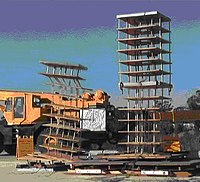
Photo from wikipedia
Abstract This study employs a detailed 3-D numerical modeling to investigate the fire-resistance behavior of the damaged steel portal frame with reduced beam section (RBS) connections. Ignoring the material damage… Click to show full abstract
Abstract This study employs a detailed 3-D numerical modeling to investigate the fire-resistance behavior of the damaged steel portal frame with reduced beam section (RBS) connections. Ignoring the material damage parameters, and the detrimental influence of residual stresses and geometrical imperfections in the previous numerical researches has given an unrealistic response in the subsequent fire analyses. Damages were induced by the cyclic loading protocol and considering damage parameters. Then, mechanical-thermal analysis was carried out by adopting a standard fire scenario, as per ISO-834. The analysis results indicate the necessity of considering damage parameters to improve the reliability of the approach. It is revealed that fire develops thermal stresses in the bottom flange of the RBS beam. These stresses lead to severe deformation in the RBS zone, thus influencing its vital performance. Damages induced by cyclic loading drastically reduce the fire-resistance period of the frame. Once the maximum drift exceeds three times the yield limit, the steel frame is practically not capable of resisting fire. Applying extra fire load to the frame with residual lateral displacement, when the maximum lateral displacement is greater than the yield limit, the frame can only sustain the stability for less than 2 min, which will also diminish by increasing the axial column load. Through conducting a subsequent case study, it was found that the fire-resistance time of the frame is increased by decreasing the DoI of the structure at equal cyclic loadings.
Journal Title: Journal of Constructional Steel Research
Year Published: 2021
Link to full text (if available)
Share on Social Media: Sign Up to like & get
recommendations!